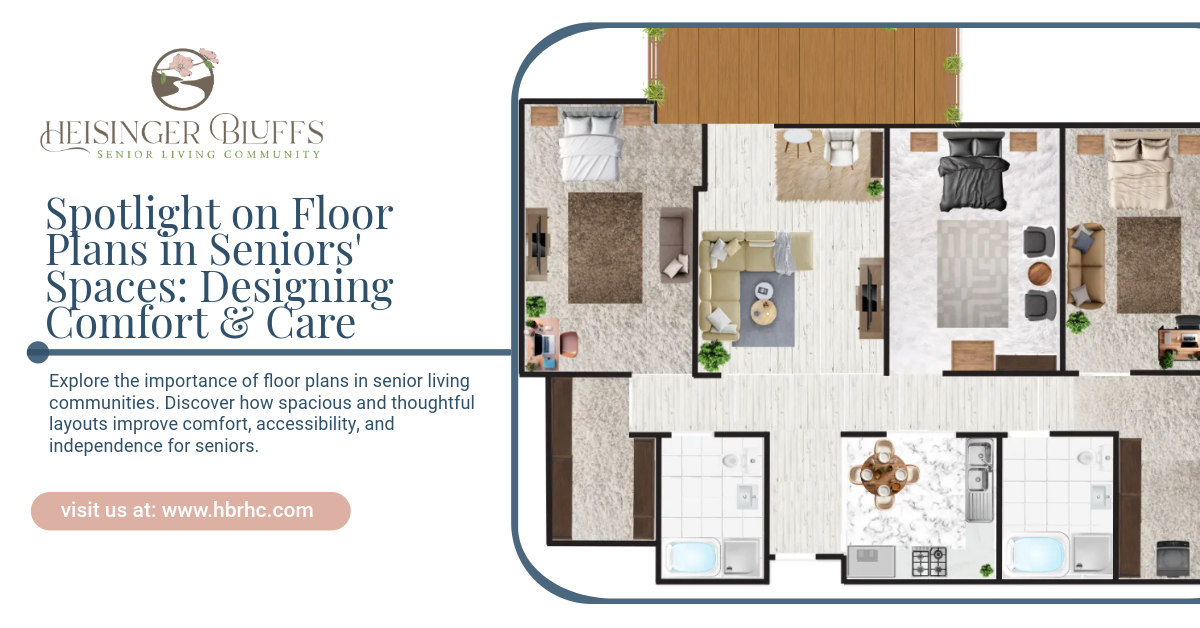Spotlight on Floor Plans in Seniors' Spaces: Designing Comfort & Care

Choosing a senior living space is more than just picking a location — the layout and design of the apartment can significantly impact a resident’s daily comfort, safety, and independence. Thoughtful floor plans tailored to seniors’ unique needs play a crucial role in fostering a positive living experience. From independent living apartments to assisted living and memory care units, the design can promote freedom, ease of movement, and a sense of home.
In this blog, we spotlight the essential features of senior living floor plans and how they benefit residents. We'll also explore specific apartment layouts to illustrate these principles in action.
Why Floor Plans Matter in Senior Living
Accessibility and Safety
A well-designed floor plan ensures easy access to every part of the apartment without obstacles. Wide doorways and hallways accommodate wheelchairs and walkers, while open spaces reduce the risk of trips and falls. Bathrooms with ample room for mobility aids and grab bars enhance safety.
Comfort and Independence
Spacious living areas provide seniors with the comfort they deserve and enable them to carry out daily activities independently. Having separate spaces for sleeping, dining, and relaxing helps maintain routines and personal privacy.
Social and Emotional Well-being
Floor plans that incorporate balconies, patios, or communal spaces encourage residents to socialize and engage with their surroundings. Natural light and outdoor views contribute to mental well-being.
Flexibility and Personalization
Many senior living communities offer a variety of floor plans to suit different preferences and needs. From studios to two-bedroom apartments, these options allow seniors to choose the space that feels like home.
Exploring Popular Senior Living Floor Plans
Let’s examine some common floor plans found in senior living communities and the unique benefits they offer.
| Floor Plan Type | Key Features | Ideal For |
|---|---|---|
| Independent Living Apartments | Open layouts, private bedrooms, full kitchens | Active seniors seeking autonomy |
| Assisted Living Apartments | Compact, safe designs with support features | Seniors needing help with daily tasks |
| Memory Care Studios | Smaller, secure units with calming layouts | Residents with dementia or memory loss |
| Two-Bedroom Suites | Extra space for visitors or personal use | Couples or those needing room to grow |
Independent Living: Spacious and Functional
Independent living apartments often feature open floor plans designed for active seniors who value autonomy. These units include full kitchens, large living areas, and private bedrooms. The layouts typically maximize natural light and offer access to outdoor spaces such as balconies or patios. This setup encourages a healthy, independent lifestyle with the comforts of home.
Assisted Living: Safety and Support
Assisted living units balance independence with support. These apartments often have more compact layouts but include safety features like grab bars, non-slip floors, and emergency call systems. The design focuses on minimizing obstacles while providing sufficient space for caregivers to assist when needed.
Memory Care: Security and Comfort
Memory care apartments prioritize security and comfort with smaller, calming layouts. These units reduce sensory overload and promote a safe environment, with easy-to-navigate designs that help residents feel more confident and less disoriented.
Two-Bedroom Options: Space to Grow
For couples or seniors who frequently host family and friends, two-bedroom apartments offer the perfect solution. These floor plans provide extra privacy and flexibility, with separate bedrooms and shared living areas designed for comfortable cohabitation.
How Floor Plans Improve Quality of Life
1. Enhanced Mobility
Spacious layouts reduce the risk of accidents and make it easier for residents to move around independently.
2. Better Accessibility
Design elements like no-step entries, wide doorways, and accessible bathrooms allow seniors with mobility challenges to live comfortably.
3. Encouragement of Social Interaction
Communal spaces and balconies create opportunities for socializing, which is vital for mental health.
4. Personalization and Familiarity
Having a floor plan that feels like home lets residents personalize their space, making the transition to senior living easier and more welcoming.
Sample Floor Plans Overview
Here are some sample apartment layouts and how their design supports seniors' needs:
- The Jefferson: This independent living apartment offers multiple bedrooms, open living and dining areas, and a balcony that brings in natural light.
- The Scotland: Features a spacious kitchen and living room area, perfect for active seniors who enjoy cooking and entertaining.
- The Greene: Compact but functional, this layout balances space and accessibility, ideal for those transitioning to assisted living.
- The Truman: Designed with convenience in mind, this plan includes ample closet space and a balcony for fresh air.
- Riverview Suites: Available in one- or two-bedroom options, these apartments offer flexible living spaces suited to different needs.
- Memory Care Studios: Smaller, secure units designed to be calming and easy to navigate.
Final Thoughts
Floor plans in senior living communities are more than just drawings—they are the foundation for safety, comfort, and a fulfilling lifestyle designed to meet seniors’ unique needs. At Heisinger Bluffs, thoughtfully crafted layouts promote independence, well-being, and a true sense of home.
Whether you’re looking for an independent living apartment with spacious rooms and a full kitchen or a secure memory care studio tailored for safety and comfort, the right floor plan can make all the difference.
As you explore senior living options, we encourage you to take a closer look at the floor plans available at Heisinger Bluffs. Contact us today to learn more or schedule a tour to find the perfect home that fits your lifestyle and needs.
Frequently Asked Questions
What should I look for in a senior living floor plan?
Look for accessibility features like wide doorways, step-free entries, and spacious bathrooms. Also, consider the size of living spaces and availability of outdoor areas.
How do assisted living floor plans differ from independent living?
Assisted living floor plans typically focus more on safety and ease of care, with features such as grab bars and emergency call systems, while independent living offers more freedom and home-like amenities.
Can I personalize my senior living apartment?
Yes, most senior living communities encourage residents to personalize their spaces with furniture, decorations, and personal items to create a comfortable, familiar environment.
Sources:
- https://www.nia.nih.gov/health/falls-and-falls-prevention/falls-and-fractures-older-adults-causes-and-prevention
- https://www.ncoa.org/product-resources/medical-alert-systems/best-medical-alert-systems/
- https://newsroom.clevelandclinic.org/2022/12/09/why-socialization-is-important-for-older-adults
- https://www.psu.edu/news/research/story/socializing-may-improve-older-adults-cognitive-function-daily-life











